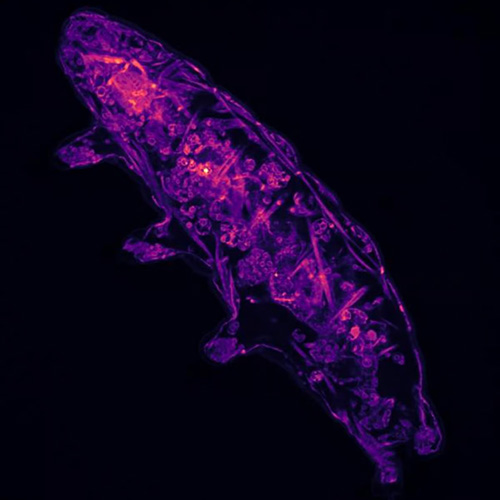Molecular sensor enables water bear hardiness by triggering dormancy
Tardigrades – hardy, microscopic animals commonly known as “water bears” – use a molecular sensor that detects harmful conditions in their environment, telling them when to go dormant and when to resume normal life. A team led by Derrick R. J. Kolling of Marshall University and Leslie M. Hicks of the University of North Carolina at Chapel Hill report these findings in a new study published January 17 in the open-access journal PLoS ONE.

Water bears are famous for their ability to withstand extreme conditions, and can survive freezing, radiation, and environments without oxygen or water. They persist by going dormant and entering a tun state, in which their bodies become dehydrated, their eight legs retract and their metabolism slows to almost undetectable levels. Previously, little was known about what signals water bears to enter and leave this state.
In the new study, researchers exposed water bears to freezing temperatures or high levels of hydrogen peroxide, salt or sugar to trigger dormancy. In response to these harmful conditions, the animals’ cells produced damaging oxygen free radicals. The researchers found that water bears use a molecular sensor—based on the amino acid cysteine—which signals the animals to enter the tun state when it is oxidized by oxygen free radicals. Once conditions improve and the free radicals disappear, the sensor is no longer oxidized, and the water bears emerge from dormancy. When the researchers applied chemicals that block cysteine, the water bears could not detect the free radicals and failed to go dormant.
Altogether, the new results indicate that cysteine is a key sensor for turning dormancy on and off in response to multiple stressors, including freezing temperatures, toxins and concentrated levels of salt or other compounds in the environment. The findings suggest that cysteine oxidation is a vital regulatory mechanism that contributes to water bears’ remarkable hardiness and helps them survive in ever-changing environments.
"Our work reveals that tardigrade survival to stress conditions is dependent on reversible cysteine oxidation, through which reactive oxygen species serve as a sensor to enable tardigrades to respond to external changes," the authors stated.Enjoy reading ASBMB Today?
Become a member to receive the print edition four times a year and the digital edition monthly.
Learn moreGet the latest from ASBMB Today
Enter your email address, and we’ll send you a weekly email with recent articles, interviews and more.
Latest in Science
Science highlights or most popular articles

E-cigarettes drive irreversible lung damage via free radicals
E-cigarettes are often thought to be safer because they lack many of the carcinogens found in tobacco cigarettes. However, scientists recently found that exposure to e-cigarette vapor can cause severe, irreversible lung damage.

Using DNA barcodes to capture local biodiversity
Undergraduate at the University of California, Santa Barbara, leads citizen science initiative to engage the public in DNA barcoding to catalog local biodiversity, fostering community involvement in science.

Targeting Toxoplasma parasites and their protein accomplices
Researchers identify that a Toxoplasma gondii enzyme drives parasite's survival. Read more about this recent study from the Journal of Lipid Research.

Scavenger protein receptor aids the transport of lipoproteins
Scientists elucidated how two major splice variants of scavenger receptors affect cellular localization in endothelial cells. Read more about this recent study from the Journal of Lipid Research.

Fat cells are a culprit in osteoporosis
Scientists reveal that lipid transfer from bone marrow adipocytes to osteoblasts impairs bone formation by downregulating osteogenic proteins and inducing ferroptosis. Read more about this recent study from the Journal of Lipid Research.

Unraveling oncogenesis: What makes cancer tick?
Learn about the ASBMB 2025 symposium on oncogenic hubs: chromatin regulatory and transcriptional complexes in cancer.

